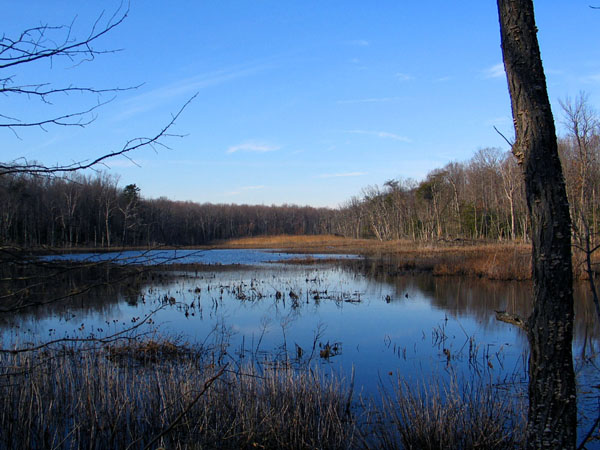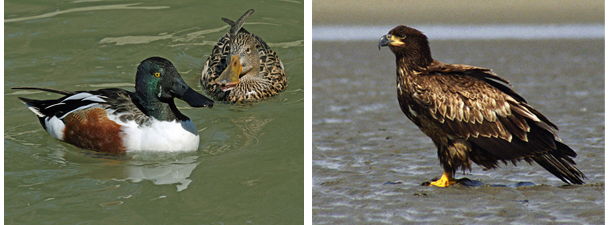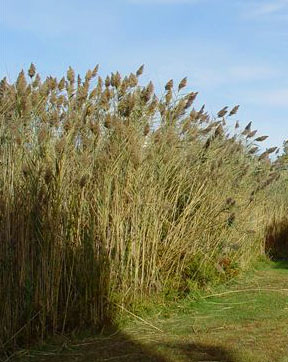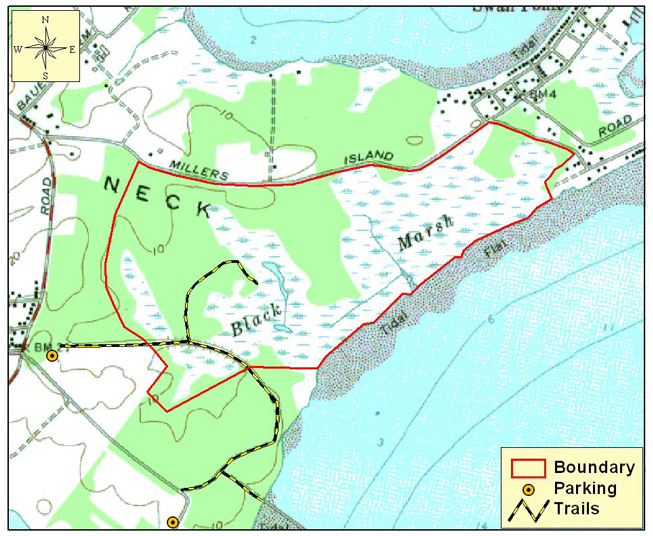Black Marsh, Baltimore County
 Despite its close proximity to the heavily developed areas of Baltimore County, Black Marsh Natural Area is amazingly wild and natural. The relatively undisturbed tidal freshwater/brackish wetland is uncommon in the northern part of the Chesapeake Bay. Within this system, a variety of wetland wildlife can be found. The rare and elusive least bittern (Ixobrychus exilis) has been found breeding in the marshes along with Virginia rails. Bald eagles are a frequent sight throughout the summer, while autumn and winter bring a diversity of dabbling ducks to the marsh.
Despite its close proximity to the heavily developed areas of Baltimore County, Black Marsh Natural Area is amazingly wild and natural. The relatively undisturbed tidal freshwater/brackish wetland is uncommon in the northern part of the Chesapeake Bay. Within this system, a variety of wetland wildlife can be found. The rare and elusive least bittern (Ixobrychus exilis) has been found breeding in the marshes along with Virginia rails. Bald eagles are a frequent sight throughout the summer, while autumn and winter bring a diversity of dabbling ducks to the marsh.
Black Marsh Natural Area is an integral part of North Point State Park, managed by the Maryland Park Service. The lush marsh contains a variety of wetland grasses, marsh-loving shrubs, and flowers like the unusual rattlesnake-master and the attractive tickseed sunflower. The land side of the marsh is surrounded by a mature forest.

City Escape
In the early twentieth century, the beaches south of Black Marsh were attractive getaways for Baltimore City residents looking to escape the humdrum life and heat of the city. For the price of a trolley ride, young and old alike could seek respite from the city's oppressive summer heat at a bathing beach, large picnic area and amusement attractions at the Bay Shore Park Amusement park, which operated from 1906 to 1947. Walk the original trolley trail as you watch winter waterfowl congregate in the Black Marsh Natural Area. Look at the massive powerhouse, which was a power station for the trolley cars in the days of Bay Shore Amusement park. Please note that while the powerhouse is a marvel to look at, it is not open to the public.

 Reed, Reed Go Away!
Reed, Reed Go Away!
One of the greatest threats to this marsh system is the invasive common reed. This clonal grass reproduces vegetatively. In vegetative reproduction, genetically identical new growth detaches and develops from the parent plant without the need for pollination. Because of this, common reed can quickly crowd out native plant species that benefit wildlife. To preserve Black Marsh Natural Area, efforts to control or eradicate common reed are needed.
Click here for a Print Version of this map.

Directions
From North Baltimore: Travel I-695 (Baltimore Beltway) south towards Essex/Key Bridge. Take Exit 42 and bear right (south) onto MD 151 (North Point Boulevard). At the first light, turn left onto MD 158 (Bethlehem Boulevard), which bends right in 0.1 mile and becomes MD 20 (North Point Road). Continue about 2 miles, staying left at the fork, to North Point State Park on the left.
From South Baltimore: Travel I-695 (Baltimore Beltway) north towards Glen Burnie/Key Bridge. Cross the Key Bridge and take Exit 43. At the first (blinking) light, turn left (east) onto MD 158 (Bethlehem Boulevard). Continue about 1 mile and go straight across MD 151 (North Point Boulevard). In 0.1 mile the road bends right and becomes MD 20 (North Point Road). Continue about 2 miles, staying left at the fork, to North Point State Park on the left.


Driving directions and aerial views open with Google Maps. For the aerial view button, if an aerial view does not open by default, click on the Satellite icon in the upper right corner and Google Maps will switch to an aerial view of the Natural Area.

Acknowledgments
Scenic View of Black Marsh. Photo by: Dave Brinker
Wildlife Collage One: (left to right)
A common buckeye feeds on the flower of a rattlesnake-master. Despite this plant's odd appearance, it is in the same family as parsley. Photo by: Dr. Thomas G. Barnes/USFWS
When spotted by a predator, the secretive least bittern will "disappear" into the marsh by standing perfectly still. Photo by: Richard Orr
Tickseed sunflowers add a brilliance of color to the marsh in late summer. Photo by: R.H. Wiegand
Wildlife Collage Two: (left to right)
Dabbling ducks like this pair of northern shovelers are a common sight in fall and winter. Photo by: Wikimedia Commons
Immature bald eagles lack the distinctive white head and tail of the adults and are sometimes mistaken for golden eagles. Photo by: Wikimedia Commons
Common reed is an ever increasing threat to the Black Marsh wetlands. Photo by: USFWS